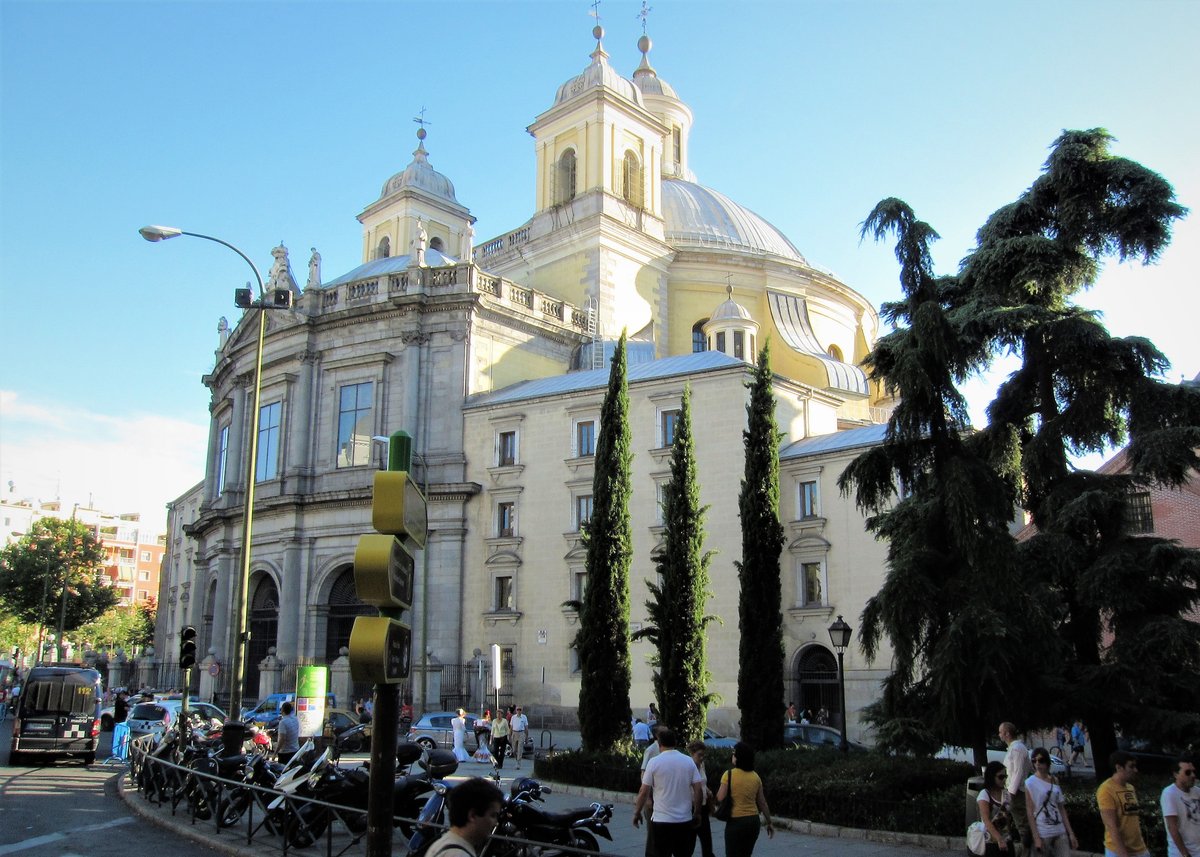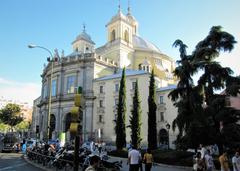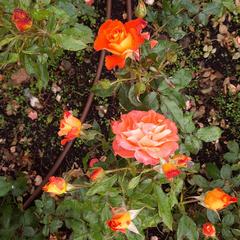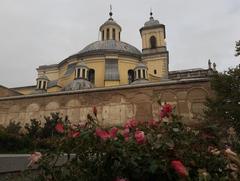
Royal Basilica of Saint Francis the Great Madrid: Visiting Hours, Tickets, and Historical Sites Guide
Date: 14/06/2025
Introduction
The Royal Basilica of Saint Francis the Great (Basílica de San Francisco el Grande) is a monumental landmark in central Madrid, acclaimed for its neoclassical architecture, immense dome, and collection of masterpieces by Spanish artists. Rooted in the city’s spiritual and artistic traditions, the basilica traces its origins to a 13th-century Franciscan hermitage, believed by legend to have been founded by Saint Francis of Assisi. Over centuries, it has grown into a symbol of Madrid’s religious and cultural identity, serving as both a center for worship and a national pantheon. This comprehensive guide details the basilica’s history, architectural highlights, visiting hours, ticket options, accessibility features, and nearby attractions to help you plan an enriching visit. For further details, consult resources such as Wikipedia, esmadrid.com, Spain.info, Nomadic Niko, and Lonely Planet.
Table of Contents
- Origins and Early Foundations
- Medieval to Modern Transformations
- 18th-Century Rebuilding and Neoclassical Vision
- 19th and 20th Century: Secularization and Restoration
- Artistic and Cultural Legacy
- Architecture and Notable Features
- Visiting Hours, Tickets, and Accessibility
- Visitor Experience: Travel Tips and Nearby Attractions
- Cultural Etiquette and Practical Advice
- FAQs
- Safety, Preservation, and Unique Experiences
- Interactive Map and Virtual Tour
- Conclusion
- References
Origins and Early Foundations
Legend holds that Saint Francis of Assisi established a humble hermitage on this site in 1217 during his pilgrimage to Santiago de Compostela (Wikipedia; Nomadic Niko). By the 13th and 14th centuries, the hermitage evolved into a Franciscan convent, establishing the location as a vital religious center in Madrid.
Medieval to Modern Transformations
During the Middle Ages, the convent expanded in size and influence, serving religious and community needs. By the 16th century, it was a significant institution, though the structures remained modest. Over the centuries, it was rebuilt several times, with at least three earlier churches preceding the current basilica (esmadrid.com). The convent’s role shifted during political upheavals, at times functioning as a military barracks or prison (Nomadic Niko).
18th-Century Rebuilding and Neoclassical Vision
The most dramatic transformation came in the mid-18th century. By order of King Charles III, the original convent was demolished, and construction of a grand neoclassical basilica began in 1760, led first by Francisco Cabezas and later by Antonio Pló and Francesco Sabatini (Wikipedia; esmadrid.com). The basilica was consecrated in 1784, boasting the largest dome in Spain and the fourth largest in Europe, rivaled only by the Pantheon, St. Peter’s Basilica, and Florence Cathedral (Wikipedia; Viajeray Mochilero).
19th and 20th Century: Secularization and Restoration
In 1836, during Spain’s ecclesiastical confiscations, the Franciscans were expelled and the basilica repurposed for secular uses, including serving as a pantheon for illustrious Spaniards (Nomadic Niko). The dome and much of the interior were completed later in the 19th century, and unique change-ringing bells were installed (Wikipedia). The Franciscans returned in 1926, and in 1963, Pope John XXIII elevated the church to the rank of minor basilica. In 1980, it was declared a national historic-artistic monument (Wikipedia).
Artistic and Cultural Legacy
The basilica is a showcase for Spanish religious art from the 17th to 19th centuries, featuring works by Francisco Goya, Francisco de Zurbarán, and others (esmadrid.com; Nomadic Niko). The main rotunda holds twelve Carrara marble statues of the Apostles, while the chapels display unique domes and art. A dedicated museum further explores the life and legacy of Saint Francis of Assisi.
Architecture and Notable Features
Exterior Design and Façade
The basilica’s neoclassical façade is marked by sober elegance, with two flanking towers and an immense central dome—33 meters in diameter and 58 meters high (Lonely Planet, Spain.info). The adjacent Baroque chapel of Cristo de los Dolores provides decorative contrast (Spain.info).
The Dome: Engineering and Artistic Marvel
The dome is both an engineering triumph and an artistic focal point, ranking among the largest in Europe (Lonely Planet). Its lavishly decorated interior features frescoes and gilded ornamentation, with acoustics that enhance liturgical music.
Interior Layout, Chapels, and Sacristy
The centralized plan draws visitors’ attention to the high altar beneath the dome, surrounded by seven radiating chapels. The ante-sacristy and inner sacristy house exceptional works, including paintings by Alonso Cano, Francisco Zurbarán, and others (Lonely Planet).
Artistic Highlights
Key highlights include Goya’s “St. Bernardino of Siena Preaching to Alfonso V of Aragon” and numerous works by Spanish masters (Spain.info). The basilica’s decoration harmonizes gold leaf, marble, and fine woodwork to create a solemn, luminous effect.
Visiting Hours, Tickets, and Accessibility
- Hours: Generally open Tuesday to Sunday, 10:00 AM–2:00 PM and 4:00 PM–6:30 PM. Closed Mondays and on certain holidays.
- Tickets: General admission is €5, with reduced rates for students, seniors, and residents. Children under 12 and some residents may enter free. Guided tours (Spanish/English) are available and recommended (official basilica website, esmadrid.com).
- Accessibility: Most areas are wheelchair accessible. Ramps are provided; some chapels and the sacristy may require assistance.
- Booking: Purchase tickets onsite or online. Advance booking is suggested in peak season.
Visitor Experience: Travel Tips and Nearby Attractions
- Getting There: Located in La Latina (Plaza de San Francisco el Grande, 28005 Madrid). Metro: La Latina (Line 5); several bus lines serve the area.
- Best Time to Visit: Weekday mornings and late afternoons are quieter. Avoid religious holidays for a less crowded visit.
- Nearby Attractions: Dalieda de San Francisco gardens, Royal Palace, Almudena Cathedral, Mercado de la Cebada, Plaza Mayor, and tapas bars along Cava Baja.
- Suggested Itinerary: Combine your basilica visit with a walking tour of La Latina and Madrid’s historic center.
Cultural Etiquette and Practical Advice
- Dress modestly (cover shoulders/knees).
- Keep noise to a minimum; silence is appreciated during services.
- Photography is allowed in most areas (no flash or tripods). Check for restrictions during religious events.
- Allocate 60–90 minutes for a complete visit.
FAQs
Q: What are the visiting hours?
A: Tuesday–Sunday, 10:00 AM–2:00 PM and 4:00 PM–6:30 PM; closed Mondays and certain holidays.
Q: How much are tickets?
A: General admission is €5; discounts for students, seniors, children, and residents.
Q: Is the basilica accessible?
A: Most public areas are accessible; some chapels may require assistance.
Q: Are guided tours available?
A: Yes, in Spanish and English; highly recommended.
Q: Can I take photos inside?
A: Photography is allowed in most areas, but flash and tripods are prohibited.
Q: What else is nearby?
A: Dalieda de San Francisco, Royal Palace, Almudena Cathedral, Mercado de la Cebada, and more.
Safety, Preservation, and Unique Experiences
The basilica is well-maintained, with ongoing restoration efforts. Visitors are asked to respect all barriers and artworks. The basilica hosts occasional concerts and cultural events; check the official website for schedules.
Interactive Map and Virtual Tour
Explore the basilica and its surroundings with the interactive map and virtual tour provided by Madrid’s tourism portal.
Conclusion
The Royal Basilica of Saint Francis the Great is a cornerstone of Madrid’s religious, artistic, and historical landscape. Its massive dome, remarkable art, and deep spiritual roots make it a must-see for visitors. To maximize your experience, check current visiting hours, book guided tours, and explore the vibrant La Latina neighborhood.
Enhance your visit by downloading the Audiala app for audio guides and personalized tours. Follow official tourism channels for updates, and discover more about Madrid’s cultural heritage through related posts and travel resources.




































































































